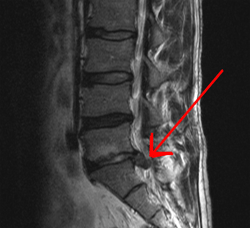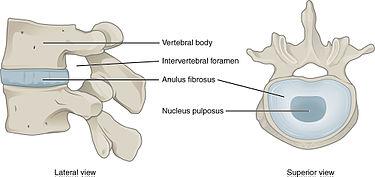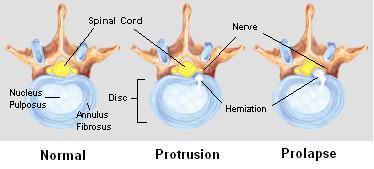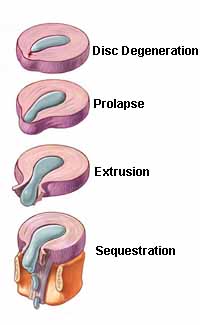|
BOOK NOW |
ASK ABOUT YOUR PAIN |
Home > Blog > Spine Physiotherapy > Slipped And Herniated Disc In The Back And Neck
Slipped And Herniated Disc In The Back And Neck

A herniated disc is known also ask disc buldge, compressed disc, herniated intervertebral disc, herniated nucleus pulposus, prolapsed disc, ruptured disc and the most inaccurate term of all, slipped disc. Interestingly, slipped/herniated discs is one of the more well-known spine conditions yet few truly knows what it really means - let's study that today.
Structure of a disc

A spinal or inter-vertabral (IV) disc sits between two spinal vertebrae and acts mainly as a shock-absorbing cushion to relief pressure off the spine joints and bones.
Most people imagine the disc as a rubber disc with a soft jelly-like centre, something like a jellied donut but actually it's more accurate to imagine a ball of jelly that's encased with hundreds of very thin but very strong layers of fibre sheets. This fibre sheets is outside and is known as annulus fibrosus, and it covers/surrounds the inner ball of jelly, nucleus pulposus.
How our spine disc works
The disc sits in the center of two spine bones, and it's pretty much semi-firm. When there are forces applied to the bones, it will transmit the same forces to the disc, so
- if the force is one side, then that side, the disc will be compressed and the disc will be "squeezed" forwards
- if the force is equal, then force on the disc is spread out equally on all sides
The challenge happens when/if force occurs on one side for an extended period of time, the disc may risk becoming permanently stretched on one end, and even when it's "released" is may not return back to default position/size. The more often/longer one stretches the disc, the longer and looser it gets over time.
Stages of disc herniation
The spine discs doesn't burst "all of a sudden" unless
it is crushed/squeezed extremely hard (like in accidents). More often than not, our disc damage is more often due to getting stretched gradually over
time - a gradual process happening over each fibre at a time.
Bulging Disc
This stage is considered early stage, where the spine disc is stretched/elongated but isn't able to return back to normal shape even when pressure/force is relieved - retaining slight bulge/elongation. Here, some of the disc fibres may be damaged or torn and the soft jelly may be spilling out into the disc fibers but not out of the disc.
Prolapsed Disc

If/when this happens, one can see on imaging that the bulge is very obvious/prominent and that the soft jelly center has spilled out to the insider of the outer fibres.
disc full Herniation
In the case of a herniated spinal disc, the soft jelly inside has completely spilled out of the disc and now protruding out of the disc fibres.
Sequestered Disc

Sequestration refers to the inner jelly material breaking out and leaking from the disc into outer, surrounding areas.
Can disc injuries heal?
....unfortunately, no.
A damaged disc cannot heal. It's got to do with not having direct blood supply (that carries nutrient rich blood), being of a cellular nature that doesn't/can't regenerate.
This means that once the disc fibres are stretched or damaged...it's not possible to revert back to normal.
will there be pain??
There are a couple of nerve endings in the spinal discs, and they're generally at the edge of the disc, this means that usually there's little-to-no pain experienced from:
- degenerative discs
- bulging discs
- herniated discs
Most of the time, any pain experienced from a herniated disc is moreso caused by the disc itself or the soft inner jelly core pressing into/onto nearby structures which contain more nerve endings. This means that you may have herniated disc but yet don't experience any pain if the herniated disc doesn't press against any nerves or structures.
If you have back pain or suspect slipped/herniated disc, do not hesitate to contact us and we will assist to advise and treat you as soon as possible.